reviews
For additional reviews of French-language resources, visit Pour parler profession. With the exception of some classroom sets, items reviewed are available on loan from the Margaret Wilson Library at the College. Contact us at 416-961-8800 (toll-free in Ontario 1-888-534-2222), ext. 679 or email library@oct.ca.
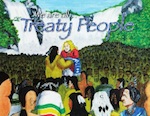
We are all Treaty People
BY MAURICE SWITZER
We are all … Treaty People is a beautifully illustrated graphic history that presents an Anishnaabek perspective on native treaty rights. After describing the historical and cultural roots of the Anishnaabek, it chronicles the early contact and relationships with Europeans and the resulting tensions as First Nations clashed with the newcomers.
In outlining the treaties formulated between the native peoples and the Europeans, Switzer shows how peaceful settlements were made possible and how they came to be interpreted by successive Canadian governments. He touches on the cultural climate of the 19th century with the waves of immigrants moving into the country and their need for increasingly large swaths of land. He goes on to describe the Indian Act of 1876, the system of Indian reserves and the residential school system, the creation of the Assembly of First Nations in 1982, the high-profile standoffs between First Nations and the provincial and the federal governments in the 1990s, and the recom-mendations from the Royal Commission on Aboriginal Peoples in 1996.
The concluding message is targeted and to the point: “Treaty promises will be fulfilled when First Nations children can look forward to accessing the same educational opportunities, the same quality health care and the same job prospects as their neighbours.”
We are all … Treaty People, Union of Ontario Indians, North Bay, 2011, softcover, ISBN 978-0-9868211-0-3, 34 pages, $25, anishinabek.ca
Nadira Baksh, OCT, is enjoying an extended parental leave. She has recently completed a combined honours specialist degree in English and history.

Nation to Nation: A resource on treaties in Ontario
BY DAVID SHANAHAN, ALAN CORBIERE AND EDITED BY MAURICE SWITZER
In Nation to Nation: A resource on treaties in Ontario, Switzer collaborates with David Shanahan and Alan Ojiig Corbiere to compile a highly readable compact text on the treaties between the First Nations and Europeans. Explanations contextualizing official treaties with current events offer deeper understanding of what the issues are. The illustrations and photographs, together with the descriptions of the treaties could be used as a prompt to consider primary documents. The articles clearly show alternative perspectives to those of many textbooks used in Grades 6 to 8 studies. Middle-school students will practise their critical reading skills as they develop their inquiry and historical thinking abilities. The book could also be used as a resource at the secondary level.
We are all … Treaty People and Nation to Nation, published by the Union of Ontario Indians-Anishinabek Nation, can easily be incorporated into the Grade 6 social studies curriculum or into the Grade 7 and 8 history curricula. They provide a rich under- standing of First Nations’ perspectives and extend the specific expectations outlined in the curriculum.
Nation to Nation: A resource on treaties in Ontario, Union of Ontario Indians, North Bay, 2013, softcover, ISBN 978-0-9868211-1-0, 68 pages, $40, anishinabek.ca
Nadira Baksh, OCT, is enjoying an extended parental leave. She has recently completed a combined honours specialist degree in English and history.
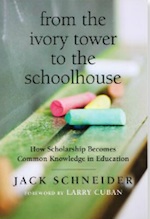
From the Ivory Tower to the Schoolhouse
BY JACK SCHNEIDER
Education historian Jack Schneider sets out to answer two questions: first, what are the common characteristics of educational research that teachers adopt into the classroom, and second, what do they reveal about the connection between research and practice in American education?
To answer the first question, the author compares and contrasts four ideas that have successfully transferred from research into the classroom context — Bloom’s Taxonomy, Multiple Intelligences, the Project Method and Direct Instruction. He then looks at four counterparts that did not fare as well — Taxonomy of the Affective Domain, Triarchic Theory, Generative Learning and the Behavior Analysis Model.
Apart from the inherent quality of the research, Schneider concludes that the outcome was determined by four critical factors: perceived significance to classroom instruction, philosophical compatibility, occupational realism and transportability. Simply put, the four factors translate into whether the ideas answer important questions for teachers, fits with teachers’ self-image as professionals and whether they can be used without extensive training or changes to their practice.
Some may find the answer to the second question most interesting, which is frankly predicated on effective marketing by researchers who are trying to make a reputation for themselves and by authors and publishers seeking a profit. (In that regard, the description of the multiple intelligences movement is fascinating). Is the argument sound? Here’s my thoughtful challenge: read the book and decide whether you can apply the principles to other currently successful ideas in education such as Differentiated Instruction, Backwards Design and 21st Century Learning.
From the Ivory Tower to the Schoolhouse: How Scholarship Becomes Common Knowledge in Education, Harvard Education Press, Cambridge, ME, 2014, softcover, ISBN 978-1-61250-669-2, 276 pages, $28.45, hepg.org
Fred DuVal is a program officer with the Accreditation Unit of the College.
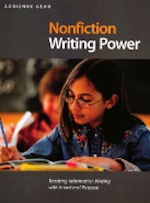
Nonfiction Writing Power
BY ADRIENNE GEAR
Young writers aspiring toward a career in writing will likely find themselves producing non-fiction — by far the largest industry for professional writers in Canada. Nonfiction Writing Power encourages teachers to develop a comprehensive program focusing on the six key forms of non-fiction writing: description, instruction, persuasion, comparison, explanation and reporting. With its nuts-and-bolts approach, this fourth book in a series about writing shows teachers how to help their elementary school students recognize what type of writing they should use for a project, how to frame their thoughts, and how to generate intent and purpose in their writing. Literacy periods begin with students engaging in a free for all brainstorming session. That is followed by examining professional models or anchor books. Students are then encouraged to organize their ideas using graphics, maps and anchor charts, followed by the drafting, editing and publishing process.
Several memory charts are suggested so that students can recall how each kind of non-fiction writing is structured. For example, “Descriptive writing says … what what what; instructional writing says … what what how; persuasive writing says … what why why…”
Gear is a practiced teacher — each chapter of Nonfiction Writing Power walks the reader through examples of the types of writing expected, clearly flowing through an organized course of activities so students can hone their skills. Chapters conclude with unique ways of assessing and reflecting on the finished results. What every good writer knows and very few students follow is emphasized repeatedly — students must immerse themselves in the writing and work at it. Just like playing the piano, you have to practise, practise, practise!
Nonfiction Writing Power, Pembroke Publishers, Markham, 2014, softcover, ISBN 978-1-55138-293-7, 160 pages, $24.95, pembrokepublishers.com
Kara Smith, OCT, is an instructor, curriculum creator and writer for the Faculty of Education, University of Windsor.
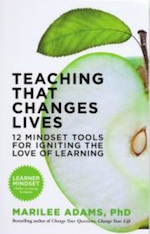
Teaching that Changes Lives
BY MARILEE ADAMS
Stories with life lessons can be powerful agents of change. In Teaching that Changes Lives, Emma Shepherd, a Grade 6 teach- er on the brink of burnout finds dynamic ways to overcome her teaching torpor, mostly by changing her mindset.
Through her struggles, insights and breakthroughs, Emma illustrates what the author calls “the learner mindset system” that is at the heart of this pedagogical resource. In so doing, she invites you to travel with her on her journey. Emma’s story is supported by a series of lessons designed to show you how to apply her learning path to your own by encouraging honest critical thinking, communication, collaboration and creativity
Learner mindset skills encourage you to think of yourself first and foremost as a fellow learner, taking the same journey as your students. It’s a way of thinking that can lead to an opening of ideas and skills that would not be revealed through a more authoritarian pedagogy. The learner mindset system is fundamentally based on the idea that inquiry is intrinsic to all learning environments — that questions are the fuel that will ignite classrooms and propel young minds toward a deep love of learning.
Included in the book are numerous graphics and lesson ideas. A website is also available for further research and for contacting the Inquiry Institute, which offers training programs for teaching the leadership skills needed to guide others toward experiencing their own breakthroughs. If you have ever wished that you had the right tools to fix something in your classroom but were confused about what to do, learner mindset tools may be a good place to start.
Teaching that Changes Lives: 12 Mindset Tools for Igniting the Love of Learning, Berrett-Koehler Publishers, San Francisco, 2013, softcover, ISBN 978-1-60994-569-5, 216 pages, US$18.95, bkconnection.com
Mary Veronica Moloney, OCT, teaches Grades 4 to 6 at D’Arcy McGee Catholic School in Toronto.
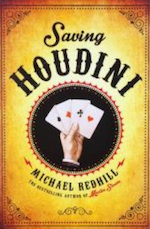
Saving Houdini
BY MICHAEL REDHILL
“Not me, not me, not me —” The year is 2011. Dash has just been chosen to go onstage in front of a thousand people with his favourite magician, Bloom the Beguiler. As if that isn’t scary enough, the trick he is about to help with is The Soap Bubble Vanish. Invented by Bloom’s grandfather, Blumenthal the Believer, it was only performed once in 1926, after which Blumenthal retired the trick, and refused to speak of it ever again. Dash enters the metal ring and a large soap bubble is formed around him. Bloom pricks it with a pin, and with a large pop, Dash finds himself alone, in the middle of the stage, in an empty auditorium.
After several confusing hours walking from the theatre to his house along the streets of downtown Toronto, Dash begins to believe and accept that the magic trick has sent him back in time, to 1926. All the men seem to be wearing hats and ties. His neighbourhood is filled with new houses. There are gravel roads where paved roads once were, tiny new trees that, just that morning, were huge.
Luckily, Dash meets Walt, a kid his age, who, while initially very skeptical of Dash’s story, quickly becomes his confidante, right- hand man and partner in the adventure that follows. And what an adventure it is! The boys realize that the only way Dash can get back to 2011 is to find Blumenthal and have him perform the trick once again. They track him down, but of course Blumenthal doesn’t believe them; he hasn’t even invented the Soap Bubble Vanish yet. This leaves the boys little choice (in their minds anyway) but to travel to Montréal by hopping the train — leading to several run-ins with railway police and child protection agents throughout the second half of the book— to ask Harry Houdini for help. Will they find Houdini? Will Houdini help them? Will they be able to prevent the famous Pickleman Punch that eventually killed Houdini? Most importantly, can they get Houdini to convince Blumenthal to invent the trick and perform it, so that Dash can go home?
Saving Houdini is a marvellous work of historical fiction, a rollicking adventure story, packed with action, time travel and magic. It is also a lovely story about the importance of friendship. Through Redhill’s wonderful descriptions of Toronto and Montréal in the 1920s, and the people Dash meets (both good and bad), the reader gets a glimpse into how society has changed in the past 100 years. Written for ages 9 to 12, this book has enough action to keep even the most reluctant reader hooked, and can easily be tied into the social studies strands (“heritage and identity” and “people and environments”), as well as the oral communication, reading and writing skills taught under the language curriculum.
Saving Houdini, Harper Collins Canada, Toronto, 2014, softcover, ISBN 978-1-44340-994-0, 272 pages, $19.99, harpercollins.ca
Terri Lawrence-Tayler, OCT, is an anatomy and physiology instructor with the nursing program at St. Clair College in Windsor.
